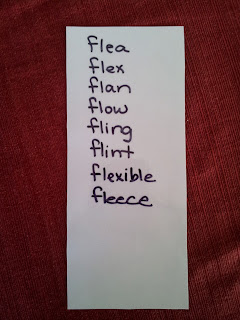Hello all, I hope all of you came through the holidays well and are looking forward to spring! Here in Texas we had 2 ice days and a couple of late starts which is highly unusual for us but I know some of you have missed much more than that! Anyway, this year I have four children who are very advanced in their reading skills. They have mastered cvc words, cvcv/cvvc words and the dolche pre-primer and primer sight words. We are now moving into intial consonant blends and digraphs. This week I started by introducing l, s and r initial blends on a binder ring, I gave each child a set and had a master set for myself. We went through each set before doing anything else. I then took the posters out for several of the l blends and we went over several objects that start with each blend. We then spent some time thinking about other words that start with this blend and recorded them on our critical thinking posters. I then used pocket chart sentences to show how we could use the words properly in a sentence and this also reinforced sight words.
We also used dry erase paddles to identify the blend of a word I said or a picture. The kiddos wrote the blend and then turned the paddle to me to see if they were correct. This shows me if they are understanding the concept and if they are keeping up with the group. After group time I had them do 3 practice stations. The first was a group station where I have the picture and words on popsicle sticks and they spread out the words on the table. They would then draw a picture from a bucket and match them. If they all felt it was correct they would "stick" the lollipops together with a paperclip and only I can unstick them. In the second station I put several drawing mats where they had to read the word and draw me a picture, they were not allowed to erase until I had seen what they drew in order to see if they had read the word correctly. They are allowed to ask a friend to help at this station. The last station is an independent station where each child has a mat wth three different blends on top. They each have a bucket filled with picture and word cards. They choose a card, match it to the proper blend and record the word on their recording sheet.
In their reading folders I have 2-3 on level books for each child to read with their parents throughout the week and I also added two resources for them to practice initial blends with. First they have their fluency bookmark which has all of the pictures and words on the front for one blend family and all of the words we thought of together on the back, I also gave them a set of stick figure blend lollipops. I have these out in the room and I randomly choose one in the day to go over during transitions.
I am already pleased with how well my class is catching onto these initial blends. Even though only one group is getting intense instruction on these I am pleased at how the others can pick things up from just looking at the stick figure lollipops, hearing the group practice and seeing the activities that go with this unit. You can find all of my Initial Blends Resources and Centers in my TpT store. Enjoy! Christine
Read the room is an excellent center activity! I use read the room almost daily in my classroom for literacy, vocabulary, letter recognition, spelling patterns and much more! I have created a bundle of read the room activities that are differentiated in order to meet the needs of all of your students no matter what level they are on. I am a firm believer in making my classroom an environment where all children are successful and feel confident in their learning. Differentiation is just one way to help those children who may be behind or even ahead to grow and flourish in the classroom. The goal is the same: learning, irregardless of where we start we want children to learn at a pace that does not frustrate and overwhelm. My Differentiated Read the Room Files contain 3 sets of picture cards. One set has the entire word printed with the picture, the 2nd set only has the target vowel written under the picture and the 3rd set only ...










Which are the indications of worldwide recognition of individuals in this modern world? As expected, amount of followers toward the Twitter account can be described as firm indicator in at present. twitter followers
ReplyDelete